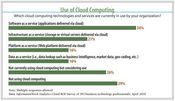AFCOM think tank tells the 85% of its members who haven't adopted cloud computing how to prepare.

| |
| |
The Data Center Institute, a think tank for data center managers, says only 14.9% of the organization's members have implemented some form of cloud computing. But, it predicts, "the next five years will see the adoption of cloud computing grow dramatically."
The report was authored by leading members of AFCOM, the former Association for Computing Operations Managers, a name it has dropped in favor of use of just its acronym.
The organization completed a survey last September which came up with the 14.9% figure. If the remainder are not thinking of moving toward the cloud, either internal or external, then the institute's position paper should act as a warning shot across the bows. The report issued Monday predicted: "Its impact on data center management will be felt throughout the industry."
Cloud computing will grow because it can address several persistent issues that plague data center operations, the position paper said. They include:
Underutilization: "Many servers in data centers are underutilized; there are still some running 3-5% of total capacity, while others actually sit idle."
Security: "Security continues to lag within most data centers... we need to focus on emerging approaches that center around the distributed model, including identity management and the new use of encryption, either within on-premise systems or within the cloud."
Ability to scale: "Businesses that need to quickly scale will typically find latency between the identification of the need and the time additional capacity can actually be brought on-line."
Cost per cycle: "Many IT budgets were slashed during the last economic downturn to force management to revisit the cost of computing, which is driving much of the data center consolidation as well as the movement toward cloud computing."
In effect, AFCOM is telling its members to "take what you've got and develop a plan to use cloud computing to get some of those attributes," said Leonard Eckhaus, founder of AFCOM, in an interview upon release of the position paper, Guiding Data Centers To Cloud Computing.
The paper adopts the same definition of cloud computing as the widely quoted National Institute of Standards and Technology, which describes a public cloud, such as Amazon's EC2; a private cloud, such as an enterprise builds for internal operation; a hybrid combination of the two; and a community cloud, where a group of organizations share a data center infrastructure.
A key tenet of cloud computing for data center managers is that it allows them "to shift the risk of handling the processing load from your enterprise data center to the cloud computing provider... the cloud provider is better suited to accept that risk," said the position paper.
Eckhaus said the paper was also intended to encourage thinking about private clouds or internal architectures that duplicate what's being done in the external cloud, such as running highly virtualized environments and multi-tenant servers. Data center managers should also be thinking about implementing self-provisioning for end users, usage tracking, and chargeback, he said.
| |
| |
The paper lists core issues for data center managers to consider if moving to a private cloud. Cloud computing is denser than its predecessor forms, with heavily virtualized hosts."You must carefully consider power management issues when moving to a cloud-based infrastructure," the paper said.
Network management will also become more focused on "processes shared between physical servers within the data center versus... communications with entities outside the data center," it said.
Virtualization under cloud computing allows flexible allocation of memory, CPU, and other resources; it's focused on multi-tenancy and auto provisioning, said the paper.
To make the move toward the cloud, the institute urges:
-- Get a realistic appraisal of where cloud computing will help with existing inadequacies. What are the business requirements that the cloud might solve?
-- Understand the existing network assets.
--Catalog servers and storage, and know the existing function of each.
--Understand data assets, the type of databases, and data models employed.
-- Catalog application assets and make explicit the databases that serve them.
-- Form a logical view of the combined existing assets to get an "as is" view of the data center.
--Draft a logical "to be" view of a cloud-enabled data center, with its network, storage, and server assets working together in a more cloud-like fashion.
-- Define the physical "to be" architecture that can support the logical view, "including selection of all the right enabling technology... This typically is the most labor-intensive portion of the process" and requires the person mapping the future architecture to have an understanding of current cloud technology.
"If I was the CIO, I'd set up a team of data center managers, facilities managers, network managers, and vendors" who supply them to get to the right cloud architecture, said Eckhaus. That 14.9% figure is going to rise. "I believe the majority of our members will be involved in the cloud 3-5 years from now," he said.
AFCOM sponsors two events a year for the 4,500 data center managers who make up the organization. The upcoming show is the 30th anniversary of AFCOM at Data Center World on Oct. 3-6 at the Mirage Hotel and Convention Center in Las Vegas.
About the Author(s)
You May Also Like










